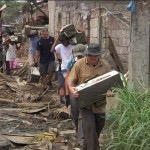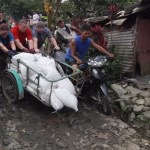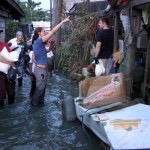Typhoon Ketsana – Philippines: Six Years Ago This Week, Millions in Desperate Need – Hotes Foundation Volunteers Alone in Providing International Assistance
The words themselves are easy to say: mudslide, landslide, earthquake, hurricane, typhoon, tsunami. They roll off the tongue. But for those who have lived through such events, or rushed into the aftermath of natural disasters, they are more than just words.
Six years ago this week, Southeast Asia experienced three natural disasters within a matter of days. In Samoa, a tsunami. In Indonesia, an earthquake. In the Philippines, a powerful typhoon. It has been called, “Asia’s Week From Hell.”
In the Hotes Foundation office, as each disaster unfolded, volunteer researchers poured over news bulletins. In the Philippines, government reports said 747 people had lost their lives and over a million were displaced when Typhoon Ketsana, also known as Tropical Storm Ondoy, dropped a month’s worth of rain in just a few hours.
“There were three major disasters all at the same time,” Richard Hotes, founder of the Hotes Foundation said, “And we chose the one we thought needed the most help, and had the most people affected.”
As difficult as it was, the decision was made. They would go to the Philippines.
Immediately, the advance team boarded a flight with their go-bags. Once in country, they would head to the hardest hit areas and source food and supplies. Back in the office, Richard briefed the volunteers who would follow the next day to distribute the bags of rice, tuna, and tents. He reminded them of the difficulties the survivors were facing and the need, as always, for having a sense of urgency.
“They don’t have their homes anymore,” he told them, “and they don’t have any food. They haven’t got water and they haven’t got electricity.” Looking his team in the eye he made sure they understood, “And nobody is there helping them.”
Hotes Foundation volunteers arrived in Manila on October 11th and made their way overland to Quezon province where Typhoon Ketsana made landfall. Because of the severe flooding, roads were often impassable, requiring the team to drive thru riverbeds or across roadless hillside, while in the shantytowns, volunteers waded through thigh deep water and traversed foul smelling quagmires. They climbed ladders and handed food up to families living on the rooftops of their flooded out homes.
For the next ten days, the volunteers worked from dawn far into the night. No matter where they went, trucks could only go so far, so the team rented rickshaws and carts of every description, and used these to shuttle supplies. When that didn’t work, volunteers packed supplies on their shoulders to hand deliver to homes, or formed human chains, tossing 25 lb. bags of rice to each other across the muddy, debris laden, flooded streets and alleyways. In the evenings, exhausted after 14 hours of continuous labor, they tipped out their black rubber boots, adding the muddy water back into the filth and puddles it had come from.
Day after day the volunteers delivered supplies. Everywhere they went they found thousands of people needing help. And always they asked who had been there before them, which NGOs?
“No,” the people said, “No NGO’s here. No one has come. You are the first.”
And this in the hardest hit places, the ones most affected.
As planned, on day six of the mission, the volunteers arrived in Payatas, a small city northeast of Quezon City and home to the Philippines largest open dump, a 50-acre landfill where a vast population manage to survive by scavenging. When the team arrived with food and shelter, they were met by local officials and armed military personnel denying them access to the dump and its population of people in need. As is often the case across the world, the government in the Philippines was seeking to direct relief aid where it wanted it to go, which did not involve helping the poorest of the poor. Not to be deterred, Richard circumvented the authorities’ orders to stay out of the dump, and with the help of a local priest got his team into Payatas.
Crossing into the dump, what the volunteers were looking at he told them was, “a disaster without a disaster having to happen.”
A mountain of garbage, 11 to 12 stories high, towered over the volunteers. It was so large that what at first appeared to be debris flapping in the wind turned out to be children scavenging for plastic bottles and food. The combination of heat and rotting waste composed a foul stench, causing many volunteers to be nauseous. Streams of black water seeped from the mountain of garbage. Volunteers distributed supplies down avenues of garbage 10 feet high that created a maze of city-like streets. In the past, methane gas explosions had earned the mountain of refuge the nickname, “Second Smokey Mountain.” As one volunteer put it, “It is literally like a combination of a community and a garbage dump.”
As Richard and the volunteers made their way deeper into the dump, many of the shanties were empty, the occupants out working the dump. For the ones where people were home, the volunteers appeared as angels, as something so out of keeping with their known world as to seem unreal. One man, stunned by the offer of a bag of rice replied to Richard, “It’s up to you sir. If you give me one, God bless you.” Even with over 30 years of experience delivering aid around the world, “It is one of the worst I’ve ever seen. If not the worst,” Richard said.
Every mission with the Hotes Foundation is difficult. Physically, mentally, and emotionally. But the fact remains that if the volunteers who went to the Philippines had stayed home, none of the people in the Payatas dump, none of those in the evacuation center in Rodriguez, no one in the school in Pinagbuhatan, and not a single person in any of the other areas the Hotes Foundation visited, would have received any help.
Six years ago, the Hotes Foundation took 30 volunteers to the Philippines. But there was also Samoa, and Sumatra. What about the survivors of those disasters? And today, what about the millions of people across the world affected by disasters who go without ever seeing a single organization coming to their aid.
And what about tomorrow, and the next time a disaster strikes?
In 2009 in the Philippines, after the last bag of rice had been handed out and the last tent and can of tuna given to a family, Richard, sweat-soaked and mud-stained, reminded his team of what they had seen, and hadn’t seen. They had gone to the hardest hit places, he said, and they were the only foreigners there distributing aid. More than that, the people affected knew that money was flowing in from all over the world, that the world aid system was taking in billions, yet not a penny or a grain of rice was getting to them. Richard paused to let that sink in, and then quietly, almost as if to himself, “And that’s got to be a terribly lonely feeling.”







